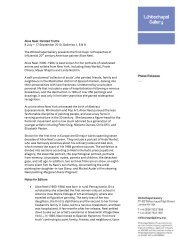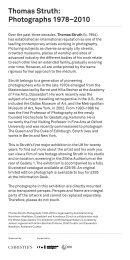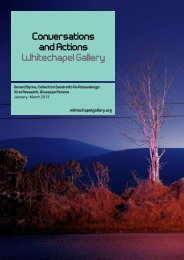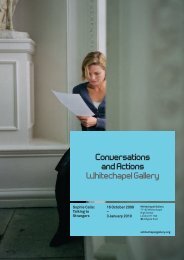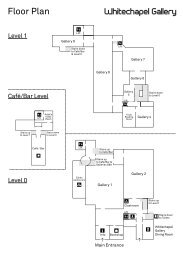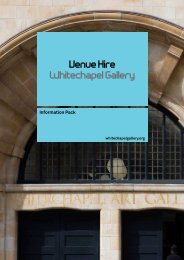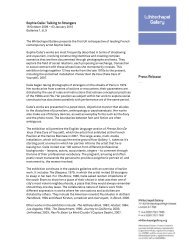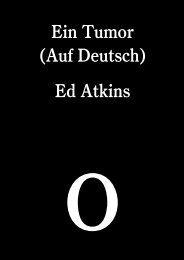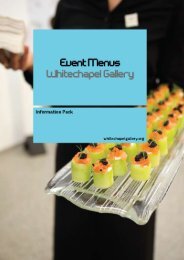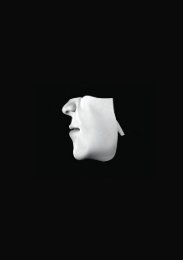Conversations and Actions Whitechapel Gallery
Conversations and Actions Whitechapel Gallery
Conversations and Actions Whitechapel Gallery
You also want an ePaper? Increase the reach of your titles
YUMPU automatically turns print PDFs into web optimized ePapers that Google loves.
<strong>Conversations</strong> <strong>and</strong><br />
<strong>Actions</strong><br />
<strong>Whitechapel</strong> <strong>Gallery</strong><br />
Keeping it Real:<br />
An Exhibition in Four Acts:<br />
Act1: The Corporeal<br />
The D. Daskalopoulos Collection
<strong>Conversations</strong> <strong>and</strong> <strong>Actions</strong><br />
This booklet has been written to help you explore a<br />
series of four displays drawn from the D. Daskalopoulos<br />
Collection, jointly titled, Keeping It Real.<br />
It contains a series of conversations between two artists,<br />
Rebecca Greathead <strong>and</strong> Daniel Wallis, <strong>and</strong> <strong>Whitechapel</strong><br />
Chief Curator Achim Borchardt-Hume.<br />
This conversation outlines key ideas <strong>and</strong> concepts from<br />
some of the artworks that appear in each display, as well<br />
as discussing the relationship between the <strong>Whitechapel</strong><br />
<strong>Gallery</strong> <strong>and</strong> public collections, with a focus on how work<br />
was selected from the D. Daskalopoulos Collection. It aims<br />
to support your exploration of the displays <strong>and</strong> gives you<br />
ideas to share with others, in your group, whatever their age.<br />
The four ‘Acts’ of Keeping It Real will be spread over the<br />
period of a year so as each display opens, an extra section<br />
will be added to this document.<br />
As some of these ‘Acts’ deal with aspects of the body we<br />
advise educators to visit the show to check suitability for<br />
your group prior to your visit.<br />
The four acts that make up Keeping It Real are:<br />
The Corporeal, 10 June – 5 September 2010,<br />
Subversive Abstraction, 17 September – 5 December 2010,<br />
Current Disturbance, 17 December 2010 – 6 March 2011,<br />
Material Intelligence, 18 March – 22 May 2011<br />
Throughout the booklet are actions that you can do in the<br />
<strong>Gallery</strong> (these appear in the boxes with the wavy lined<br />
edge) that will help you consider the artists’ ideas, working<br />
processes or more directly the work <strong>and</strong> themes of the<br />
exhibition. These actions are easily adaptable to suit a<br />
wide-range of people.<br />
Also, within the booklet are actions that can be used<br />
beyond the <strong>Gallery</strong> (these appear in the boxes with the<br />
diamond patterned edge). They too can be easily adapted.<br />
Spread throughout, are images that you can use to act as<br />
prompts or as a reminder of the exhibition.<br />
Have fun!<br />
Cady Nol<strong>and</strong> Cowboy Eating, with Holes <strong>and</strong> Scarf in Crotch Hole (1990)
Keeping It Real<br />
Rebecca<br />
Why is the <strong>Whitechapel</strong> <strong>Gallery</strong> showing someone’s private collection?<br />
Achim<br />
<strong>Whitechapel</strong> <strong>Gallery</strong> has a history of showing work from both public <strong>and</strong> private<br />
collections from all over the world. When we extended the <strong>Gallery</strong> in 2009 we had a<br />
Collections <strong>Gallery</strong> made especially for this purpose.<br />
Rebecca<br />
So why the D. Daskalopoulos Collection?<br />
Achim<br />
No one had ever seen his collection before; it had never been published or publicly<br />
documented. Some work has been lent out to other galleries, but only because their<br />
curators were looking for specific works <strong>and</strong> were directed to him via dealers who knew<br />
he’d bought them.<br />
Rebecca<br />
So, as Chief Curator at <strong>Whitechapel</strong> <strong>Gallery</strong> you were the first curator to have a chance to<br />
explore his whole collection?<br />
Achim<br />
Absolutely. I was able to look through his database, pick out a long list of works I wanted<br />
to display <strong>and</strong> then go to Athens where he is based <strong>and</strong> see them.<br />
Rebecca<br />
Why are you not showing his whole collection?<br />
Achim<br />
He is well known as a collector of large installation works, but has many small pieces<br />
too; there are 400 works in his collection. The Collections <strong>Gallery</strong> (<strong>Gallery</strong> 7) here at the<br />
<strong>Whitechapel</strong> hasn’t space for all the work, in fact we’re having four micro-exhibitions one<br />
after another, I call them four ‘Acts’.<br />
Rebecca<br />
They must tell a sort of story then.<br />
Achim<br />
Exactly. When I was planning the acts I was thinking of them like books - you read one,<br />
<strong>and</strong> then ask what now, where next? Maybe I’ll have that. Sometimes I searched for<br />
artworks, sometimes they were just there.<br />
Rebecca<br />
Did Daskalopoulos direct you <strong>and</strong> tell you which artworks he wanted to show?<br />
Achim<br />
Not at all. He was fantastically open about it all. I knew there were certain iconic works<br />
we had to show, <strong>and</strong> I wanted to give a flavour of Daskalopoulos, what makes him tick. A<br />
lot of the artwork he buys has the quality of ‘stuff’: gunky, not shiny, visceral rather than<br />
cerebral; it’s about life <strong>and</strong> death, male <strong>and</strong> female. That was my starting point for the<br />
first show.<br />
Rebecca So, the exhibitions are all about finding out who Daskalopoulos is? I know that about 30<br />
years ago he oversaw the transformation of a family dairy business into Greece’s largest<br />
food company.<br />
Achim<br />
In a way it’s all about him, he’s the missing piece of the puzzle, the person who brought<br />
the whole collection together. But I think when you come to see the exhibitions you can<br />
ignore him. It’s what you want make of it. It’s yours.
John Bock, Winona Ryder (2009)
The D. Daskalopoulos Collection<br />
Daniel<br />
It must have been interesting for you to go <strong>and</strong> select works from such a big collection,<br />
<strong>and</strong> it must have been equally enjoyable for Dakalopoulos to have the chief curator of a<br />
major international gallery explore <strong>and</strong> suggest ways to make sense of it.<br />
Achim<br />
Yes. He said it opened his eyes to new ways of looking at some of the works <strong>and</strong> making<br />
connections between them. When I was selecting work for the four acts I found it grounding<br />
to have someone who I was forced to tell my ideas to, to check I wasn’t going off the rails.<br />
Daniel<br />
As a visitor to the <strong>Whitechapel</strong> <strong>Gallery</strong> I’m really excited about having the opportunity to<br />
see works I can’t see in other London galleries, but I am wondering what Daskalopoulos<br />
might get out of exhibiting here?<br />
Achim<br />
He is passionate about art <strong>and</strong> education, but in Athens where he is based there isn’t<br />
really a strong contemporary arts scene. An exhibition at the <strong>Whitechapel</strong> <strong>Gallery</strong> will help<br />
raise the profile of his collection <strong>and</strong> open up further possibilities for its use.<br />
Activity 1 Beyond The <strong>Gallery</strong><br />
A collection of any form will reflect the personality of the collector.<br />
Think about whether you already have any collections?<br />
Make an internet search using the words ‘art collections’ or ‘contemporary art collection’ to find<br />
examples of online collections. Many galleries have their own collections, so look at their websites<br />
too.<br />
You could similarly use art books or any images collections you have available.<br />
Look through some of the collections <strong>and</strong> select a work that interests you.<br />
Using this as starting point to form your own personal collection, choose other works that are<br />
related in some way. For example, by subject matter, colour, theme, mood, artist etc.<br />
You could try to collect 6 – 10 images which all relate to each other or you could collect using a<br />
Chinese Whispers technique by selecting each work in relation to the previous one: e.g. work 2<br />
might echo the colours of work 1, work 3 might share the mood of work 2 <strong>and</strong> so on.<br />
Ask someone else in your group to try <strong>and</strong> ‘read’ your images to help unpick the method you used<br />
to chose <strong>and</strong> collate them.<br />
Ask them to think of other ways to group or link images. Discuss together how you might exhibit<br />
them to an audience.<br />
Design an exhibition to display these works:<br />
- What sort of space would you like to see them in?<br />
- How would you curate the show <strong>and</strong> arrange the artworks?<br />
- Think of a title for the show, or for the collection.<br />
- Make an advertisement for your show <strong>and</strong> write a press release.<br />
Activity 2 Beyond The <strong>Gallery</strong><br />
For a series of activities focusing on curation which will complement the <strong>Actions</strong> from this<br />
Conversation <strong>and</strong> <strong>Actions</strong> please refer to The British Council Collection: Great Early Buys teacher’s<br />
pack which can be downloaded from:<br />
http://www.whitechapelgallery.org/education/schools/teachers
David Hammons Untitled (1975)<br />
Sherrie Levine Fountain (Buddha): 5 (1996)
The Corporeal<br />
Daniel<br />
There seems to be a lot of artwork about the body in this exhibition.<br />
Rebecca<br />
Not the more traditional parts of the body either! I can see some prints of a penis here<br />
made by David Hammonds.<br />
Daniel<br />
He has also made a printed trace of his body by covering himself in margarine <strong>and</strong><br />
pressing himself against a board.<br />
Rebecca<br />
His work exposes the mere traces of black artists within Western Art history.<br />
Daniel<br />
There is a torso here on the floor; it looks like it is made from wax. With real hair<br />
embedded in it.<br />
Rebecca<br />
It has both female <strong>and</strong> male parts.<br />
Daniel<br />
There are other works made from hair, a piece by Despina Isaia where the hair has been<br />
crocheted <strong>and</strong> hair which is woven into a graphic pattern by David Hammonds.<br />
Rebecca<br />
The delicate blue drawing by Jim Hodges is made using saliva to transfer ink from one<br />
piece of paper onto another.<br />
Daniel<br />
Even the works that are not obviously body parts make reference to the body.<br />
Rebecca<br />
A vulnerable body with holes <strong>and</strong> protrusions rather than an idealised version.<br />
Daniel<br />
I can see Marcel Duchamp’s infamous urinal, is it the original one?<br />
Rebecca<br />
The original Fountain he tried to exhibit in 1917 was rejected <strong>and</strong> subsequently lost. This<br />
is one of several h<strong>and</strong>crafted replicas that Duchamp authorised to be made in the 1960s.<br />
Daniel<br />
So what was supposed to be a ubiquitous object has become something quite different.<br />
Rebecca<br />
What about this golden one next to it? It’s called Buddha, <strong>and</strong> actually looks like a Buddha<br />
from the front.<br />
Daniel<br />
This was cast in bronze by Sherrie Levine from a urinal made by the manufacturers of<br />
Duchamp’s original ‘readymade’.<br />
Rebecca<br />
Have you looked at this piece by Jimmie Durham with bullet holes as you come in the<br />
door? I find it rather sinister, yet funny at the same time.<br />
Daniel<br />
Have you noticed the bullet marks are at chest height?<br />
Rebecca<br />
Yes, in amongst these other works it is another reminder of our leaky bodies.
Action In The <strong>Gallery</strong><br />
Look for the different body parts shown overtly or alluded to by the artworks. If you put them<br />
together could you make up a whole body?<br />
Think about how you feel when looking at some of the works.<br />
Do they make you uncomfortable? Why might this be?<br />
Do they make you more aware of your own body?<br />
Do you think this was the artist/s intention?<br />
The bronze female form on the wall by Sherrie Levine is actually cast from an African mask worn as<br />
an initiation rite for young men:<br />
Can you tell it’s a mask? How?<br />
Why do you think the artist has chosen to incorporate this subject matter in the work?<br />
Are there other works that you think are gendered i.e. distinctly male or female?<br />
Are there any artworks which have aspects of both sexes in them?<br />
Action Outside The <strong>Gallery</strong><br />
Experiment with h<strong>and</strong>- <strong>and</strong> foot-print making to make new shapes maybe with reference to other<br />
parts of the body or even other objects.<br />
Research the use of hair in art:<br />
Look for other artists who use hair in their work: Search the internet for images using the following<br />
names along with the word ‘hair’. Ann Hamilton, Emily Bates, Tom Friedman, Renee Stout, Doris<br />
Salcedo, Tania Bruguera…<br />
Hair can carry enormous power <strong>and</strong> meaning both attached to the head <strong>and</strong> cut from it. These<br />
meanings can differ according to culture <strong>and</strong> time:<br />
Explore the meaning of different haircuts <strong>and</strong> styles: historically (eg. Ancient Egyptians) or socially<br />
(eg. punk hairstyles, braiding, shaving).<br />
In some countries hair plaiting <strong>and</strong> braiding is a form of Art <strong>and</strong> Craft included by the school<br />
curriculum.<br />
Shaving hair can be a form of punishment or dehumanisation (think about the Holocaust), used to<br />
empower or create an aggressive image (Skinheads) or as a form of piety (Buddhist monks).<br />
When Britney Spears shaved her head in 2007, it was front page news. Why?<br />
Long hair can be equally potent, as a symbol of sexuality or conversely as a sign of respect to ones<br />
religion as in Sikh culture. It’s meaning differs between men <strong>and</strong> women. Think about the saying,<br />
Letting your hair down – what does it actually mean?<br />
Hair cut from the head can provoke very differing emotions:<br />
Think about the different emotions evoked between looking at a baby’s first curl <strong>and</strong> finding a<br />
stranger’s hair caught in the plug hole.<br />
Many of the works in the exhibition make reference to parts of our bodies that are usually hidden<br />
i.e. parts with hair! Historically Western Art did not show pubic hair.<br />
While removing all the hair from our heads can be shocking, sometimes not removing hair from legs<br />
or underarms can be even more outrageous. It this the same for men as for women?
Marcel Duchamp Fountain (1917/1964)
End Conversation: This Is Just A Test<br />
Daniel<br />
This is an exhibition that utilises memories, building up experiences from each of the Acts.<br />
Rebecca<br />
The first Act, The Corporeal is designed to be like a heartbeat, keeping a rhythm for<br />
subsequent Acts to build on.<br />
Daniel<br />
And the second, Subversive Abstraction explores how, in attempts to create a pure<br />
language of art, the physical body still intrudes.<br />
Rebecca<br />
For the third Act a huge piece by Mona Hatoum reflects some of the themes previously<br />
introduced. Current Disturbance describes it’s buzzing <strong>and</strong> uneasy presence.<br />
Daniel<br />
Finally, Material Intelligence combines works that tend to utilise everyday materials <strong>and</strong><br />
technologies.<br />
Rebecca<br />
So I guess these works could be shown together if there was enough room?<br />
Daniel<br />
They could, but the effect would be different. Having time to digest encounters before<br />
moving on to the next can provide a richer experience.<br />
The four acts that make up Keeping It Real are:<br />
The Corporeal , 10 June – 5 September 2010,<br />
Subversive Abstraction, 17 September – 5 December,<br />
Current Disturbance, 17 December 2010 – 6 March 2011,<br />
Material Intelligence, 18 March – 22 May 2011<br />
Old Spitalfields<br />
Market<br />
Brushfield St<br />
Christ<br />
Church<br />
<strong>Whitechapel</strong><br />
Vallance Rd<br />
Liverpool<br />
Street<br />
Fashion St<br />
Toynbee St<br />
Wentworth St<br />
Commercial St<br />
Toynbee Hall<br />
Brick Ln Osborn St<br />
<strong>Whitechapel</strong><br />
<strong>Gallery</strong><br />
<strong>Whitechapel</strong> Rd<br />
The East<br />
London Mosque<br />
New Rd<br />
Angel Alley<br />
Middlesex St<br />
Aldgate<br />
St Botolph<br />
St<br />
Aldgate<br />
East<br />
<strong>Whitechapel</strong> High St<br />
Braham St<br />
Aldgate<br />
East<br />
London Metropolitan<br />
University<br />
Commercial Rd<br />
Mansell St<br />
Leman St<br />
Bus Station<br />
Alie St
Find out more<br />
For a series of activities focusing on curation which will complement the <strong>Actions</strong> from this<br />
Conversation <strong>and</strong> <strong>Actions</strong> please refer to The British Council Collection: Great Early Buys teacher’s<br />
pack which can be downloaded from here:<br />
http://www.whitechapelgallery.org/education/schools/teachers<br />
To book your free group visit <strong>and</strong><br />
use our Education Space<br />
(available Tuesday, Wednesday <strong>and</strong><br />
Thursday during term time)<br />
please call Education on 020 7522 7888<br />
or email: education@whitechapelgallery.org<br />
If you have enjoyed this <strong>Conversations</strong> <strong>and</strong> <strong>Actions</strong> or have any other feedback please do contact us.<br />
For more <strong>Conversations</strong> <strong>and</strong> <strong>Actions</strong> visit<br />
<strong>Whitechapel</strong>gallery.org/education/schools/teachers<br />
Supported by:



